Marie Laval's Blog, page 13
July 1, 2014
A lot of Sense and some Sensibility Too! How to choose the title of your novel
There are many informative articles and blog posts on the subject of naming novels, but I must confess I hadn't read any before choosing Angel heart, the title of my debut historical romance. It came to me one day, in the early stages of researching the story. I liked it because it was short. I found it catchy and easy to remember, and I liked the fact it related both to the name of my heroin and to the plot, so I stuck with it and never considered changing it.
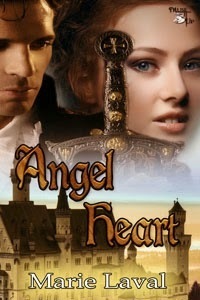 It was the same for my second historical romance, The Lion's Embrace, which once again just popped into my mind. It immediately felt right because it related to the main character - the hero this time - and the North African setting. As for the two romances I recently completed, Dancing for the Devil, and The Lady of Bellefontaine, and which will both be published by Áccent Press in the next few months, I found the titles before I even worked all out the details of the plot!
It was the same for my second historical romance, The Lion's Embrace, which once again just popped into my mind. It immediately felt right because it related to the main character - the hero this time - and the North African setting. As for the two romances I recently completed, Dancing for the Devil, and The Lady of Bellefontaine, and which will both be published by Áccent Press in the next few months, I found the titles before I even worked all out the details of the plot!
Now I have researched the topic I realize I got it all wrong and I should have taken more time and experimented with different ideas - even if I still love all my titles and would probably keep them anyway.
First and foremost, I should have 'Googled' them to make sure they didn't already exist or weren't too similar to others out there. The most important function of a title is indeed to identify your novel among the hundreds of thousands of books on the market, and a good title should be unique and make your book stand out. This makes so much sense I can't believe I didn't think of it.
Secondly, I should have waited until the end of the writing process before deciding on the name. This is because the original title you may have fallen in love with when you started writing your story may not reflect the plot, characters or style of the final manuscript and may therefore mislead or confuse potential readers. This is something else I didn't do, but then again I feel it would be too much like leaving the choice of a baby's name until after the birth, and I'm not sure I could wait that long.
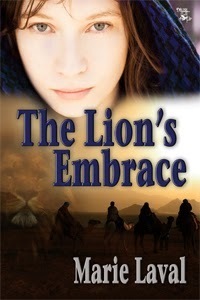
Of course, there are other factors to consider when choosing a title. Should you go for an obvious title that reflects the genre, style and content of the novel so that readers know exactly what they are buying, or choose a more intriguing titles, with different layers of meaning?
Romance novels are often easily identifiable from their title. Anything with the words 'heart', 'passion', 'temptation', 'wedding' and of course 'love' and 'heart' (I am guilty here!) could point to a romance! Add an aristocratic title - 'Viscount', 'Marquess' or 'Duke' - and you fall into the sub genre of historical romances. Further references to a geographical or historical setting will immediately appeal to a specific market. For example any mention of the Highlands or Highlanders evokes Scottish lairds, clan wars or Jacobite plots, and of course men in kilts...

Some romances have very long titles which look like mini-blurbs and give away most of the plot. There can be no doubt in the reader's mind about who the hero and heroin are, and what the conflict is going to be.
Without being too obvious some book titles give you an instant feel for the mood, or even the plot, of the novel. Even without knowing anything of the story, I doubt anyone picking up Hemingway's For Whom the Bell Tolls, Victor Hugo's Les Miserables or Steinbeck's The Grapes of Wrath will expect a cheerful read with a happy ending.
But what about an element of surprise? Is it a good idea to have a title so obscure readers have absolutely no idea about the story and they feel compelled to pick up the book and look at the blurb? Or is there a danger that they might feel let down, or even a little cheated, if the novel turns out to be somewhat less original than the title suggested?
There are of course many great novels with great titles around. Successful French novelist Katherine Pancol has a few of those, such as The Yellow Eyes of Crocodiles,Cruel Men aren't so Easy to Find, or again The Squirrels in Central Park are Sad on Mondays (my own translation since the book is not yet available in English). And what about The Hitchhiker's Guide to the Galaxyby Douglas Adams, The Devil Wears Prada, by Lauren Weisberger, One Hundred Years of Solitude, by Gabriel Garcia Marquez, or Madam, Will you Talk by Mary Stewart? I wish I could come up with one of those.
So what can you do if you are stuck and can't think of a title for your story? Using the name of the main character, or of the place or period where the novel is set is a good idea. So is referring to key words, concepts or images recurrent in the story and contrasting them (War and Peace is a classic example). Play on words or the use of alliteration will help make your title memorable (Pride and Prejudice, Sense and Sensibility), and so will rhyme (The Cat in the Hat by Dr Seuss).
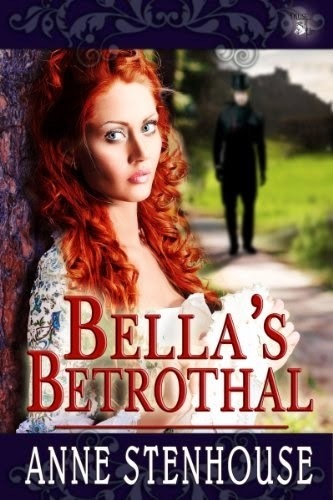
If you are planning a series, it makes sense to have catchy titles that follow on from one another or have the same style. Sue Grafton takes letters from the alphabet - A is for Alibi, B is for Burglar, C is for Corpse. Sophie Kinsella uses the same word in her Shopaholic series, and so does Kathy Reichs for her thrillers, Bones Are Forever, Devil Bones, Break No Bones. I very much like the titles fellow MuseitUp Publishing author Anne Stenhouse chose for her historical romances, Mariah's Marriage, Bella's Betrothal and her forthcoming novel Daisy's Dilemna. This is definitely something I wish I had considered for my own romantic novels, since Angel Heart, The Lion's Embrace and Dancing for the Devil are part of a trilogy.
So what about you? How do you choose the title of your novels?
And which titles do you wish you had thought of first?
 It was the same for my second historical romance, The Lion's Embrace, which once again just popped into my mind. It immediately felt right because it related to the main character - the hero this time - and the North African setting. As for the two romances I recently completed, Dancing for the Devil, and The Lady of Bellefontaine, and which will both be published by Áccent Press in the next few months, I found the titles before I even worked all out the details of the plot!
It was the same for my second historical romance, The Lion's Embrace, which once again just popped into my mind. It immediately felt right because it related to the main character - the hero this time - and the North African setting. As for the two romances I recently completed, Dancing for the Devil, and The Lady of Bellefontaine, and which will both be published by Áccent Press in the next few months, I found the titles before I even worked all out the details of the plot!Now I have researched the topic I realize I got it all wrong and I should have taken more time and experimented with different ideas - even if I still love all my titles and would probably keep them anyway.
First and foremost, I should have 'Googled' them to make sure they didn't already exist or weren't too similar to others out there. The most important function of a title is indeed to identify your novel among the hundreds of thousands of books on the market, and a good title should be unique and make your book stand out. This makes so much sense I can't believe I didn't think of it.
Secondly, I should have waited until the end of the writing process before deciding on the name. This is because the original title you may have fallen in love with when you started writing your story may not reflect the plot, characters or style of the final manuscript and may therefore mislead or confuse potential readers. This is something else I didn't do, but then again I feel it would be too much like leaving the choice of a baby's name until after the birth, and I'm not sure I could wait that long.

Of course, there are other factors to consider when choosing a title. Should you go for an obvious title that reflects the genre, style and content of the novel so that readers know exactly what they are buying, or choose a more intriguing titles, with different layers of meaning?
Romance novels are often easily identifiable from their title. Anything with the words 'heart', 'passion', 'temptation', 'wedding' and of course 'love' and 'heart' (I am guilty here!) could point to a romance! Add an aristocratic title - 'Viscount', 'Marquess' or 'Duke' - and you fall into the sub genre of historical romances. Further references to a geographical or historical setting will immediately appeal to a specific market. For example any mention of the Highlands or Highlanders evokes Scottish lairds, clan wars or Jacobite plots, and of course men in kilts...

Some romances have very long titles which look like mini-blurbs and give away most of the plot. There can be no doubt in the reader's mind about who the hero and heroin are, and what the conflict is going to be.
Without being too obvious some book titles give you an instant feel for the mood, or even the plot, of the novel. Even without knowing anything of the story, I doubt anyone picking up Hemingway's For Whom the Bell Tolls, Victor Hugo's Les Miserables or Steinbeck's The Grapes of Wrath will expect a cheerful read with a happy ending.
But what about an element of surprise? Is it a good idea to have a title so obscure readers have absolutely no idea about the story and they feel compelled to pick up the book and look at the blurb? Or is there a danger that they might feel let down, or even a little cheated, if the novel turns out to be somewhat less original than the title suggested?
There are of course many great novels with great titles around. Successful French novelist Katherine Pancol has a few of those, such as The Yellow Eyes of Crocodiles,Cruel Men aren't so Easy to Find, or again The Squirrels in Central Park are Sad on Mondays (my own translation since the book is not yet available in English). And what about The Hitchhiker's Guide to the Galaxyby Douglas Adams, The Devil Wears Prada, by Lauren Weisberger, One Hundred Years of Solitude, by Gabriel Garcia Marquez, or Madam, Will you Talk by Mary Stewart? I wish I could come up with one of those.
So what can you do if you are stuck and can't think of a title for your story? Using the name of the main character, or of the place or period where the novel is set is a good idea. So is referring to key words, concepts or images recurrent in the story and contrasting them (War and Peace is a classic example). Play on words or the use of alliteration will help make your title memorable (Pride and Prejudice, Sense and Sensibility), and so will rhyme (The Cat in the Hat by Dr Seuss).

If you are planning a series, it makes sense to have catchy titles that follow on from one another or have the same style. Sue Grafton takes letters from the alphabet - A is for Alibi, B is for Burglar, C is for Corpse. Sophie Kinsella uses the same word in her Shopaholic series, and so does Kathy Reichs for her thrillers, Bones Are Forever, Devil Bones, Break No Bones. I very much like the titles fellow MuseitUp Publishing author Anne Stenhouse chose for her historical romances, Mariah's Marriage, Bella's Betrothal and her forthcoming novel Daisy's Dilemna. This is definitely something I wish I had considered for my own romantic novels, since Angel Heart, The Lion's Embrace and Dancing for the Devil are part of a trilogy.
So what about you? How do you choose the title of your novels?
And which titles do you wish you had thought of first?
Published on July 01, 2014 14:13
June 21, 2014
My Life in a Nutshell by Tanya J. Peterson
Today I am delighted to talk to Tanya J. Peterson about her latest novel.
 My Life in a Nutshell: A Novel is the story of one man's struggles with debilitating anxiety. Brian Cunningham has isolated himself to such a degree that his human contact is barely more than an hour a day. While lonely, he feels powerless to change his life. Unexpectedly, his safe little world is invaded by one Abigail Harris, a seven-year-old girl who, for the last five years, has bounced from foster home to foster home. She has come to live with an aunt and uncle she has never known. Unsure if she can trust her new environment, she turns to Brian. Neither one quite knows how to live in the world. Can they possibly help each other?
My Life in a Nutshell: A Novel is the story of one man's struggles with debilitating anxiety. Brian Cunningham has isolated himself to such a degree that his human contact is barely more than an hour a day. While lonely, he feels powerless to change his life. Unexpectedly, his safe little world is invaded by one Abigail Harris, a seven-year-old girl who, for the last five years, has bounced from foster home to foster home. She has come to live with an aunt and uncle she has never known. Unsure if she can trust her new environment, she turns to Brian. Neither one quite knows how to live in the world. Can they possibly help each other?
Hello Tanya and thank you so much for coming on the blog today to talk about yourself and your writing. First of all, can you tell us a little about you?
Hmmm. I’m thinking about this, and I keep coming back to one word: strange! I have a blue beta fish that no one in my house would name, so I named him RedFish. I love the show Phineas and Ferb because I’m pretty sure that Dr. Doofenschmirtz is my soul mate. I tend to get myself into trouble by going against the grain and speaking up for the underdog. I love to camp and hike and kayak. Family time is amazing. I mask social anxiety by talking too much, and then I worry about it for days afterward. I’ve been a teacher, a counselor, a support group facilitator for the National Alliance on Mental Illness (US). I have bipolar 1 disorder. I’m a proud mom of two wonderful adolescents and a happy wife of my husband.
Well, you may call yourself strange, but I think you sound fascinating and it's no wonder that you became a writer. What did you want to be when you were a child? Did you always know you wanted to write? I’ve always loved writing! But after one person scoffed at a story I was writing about forest animals when I was in second grade, my creative writing days were over (yeah, I was a bit too sensitive, I think). I’ve also always wanted to help people and to make a difference in the world. For the longest time, I wanted to be a doctor. For different reasons, I became a teacher. But I really wanted to be a counselor, so I became one. Then I ended up spending some time in a behavioural health hospital (after a traumatic brain injury in a car accident) and receiving a (very accurate) diagnosis of bipolar 1 disorder. So many passions and experiences of mine have come together into novel writing, and I feel like I’m finally doing what I’ve wanted to do my whole life: write and do something to help people.
You definitely sound very brave and determined, and very passionate about your work and your writing. Where do you get your ideas for your stories, and for My Life in a Nutshell more specifically? My novels always address certain themes or concepts around mental illness/mental health. I want to use characters that people bond with to show what certain aspects of mental illness are truly like (as opposed to what is stereotyped on the news, in films, etc.). With each book, I pick something specific, create a character (and then the other characters) to reach out to readers, and then I build the story. With My Life in a Nutshell, I wanted to show what certain anxiety disorders are like because anxiety is so common and so misunderstood. I wanted to put people inside the mind of someone who lives with debilitating anxiety.
Do you have a writing routine? Sort of. I write or do some writing-related tasks every day. I think I’m the most creative in the mornings, so I try to do actual writing then. However, that’s a bit hard when my youngest child doesn’t go to school until 9:00. Additionally, I’m also a columnist for a mental health website (healthyplace.com), so I have to work on my articles in addition to my novels. It doesn’t work for me to have a rigid schedule. As long as I start my day with coffee, drink tea, water, and Sobe LifeWater throughout the day, I’m good.
What is the one thing you absolutely need to write? Quiet! (And no distractions)
So do I! Unfortunately I don't get enough of it. Can you describe your writing space? I actually don’t have a single space. I move about the house to various places that feel inspiring (and that varies from day to day). Part of that is indeed for inspiration. Part of that, though, is because my actual space (my desk in my office) can be described thus: Captain ADHD meets the Tasmanian Devil.
I wish I had a special writing space with a lovely and inspiring view, or even a 'writing shed' in my tiny garden...
In three words - What kind of man is Brain Cunningham , your hero? Caring, sensitive, anxious
And finally, what are you working on at the moment?
I’m nearly 200 pages into my latest novel, which of course is mental-health-themed! It’s about a man and his family who are struggling to adjust to his new diagnosis of…
Thank you so much Marie! I’ve enjoyed your interview, and I’m happy that you and your readers have taken the time to get to know me and my writing!
It was a pleasure talking to you Tanya. Thank you for coming on the blog. Tanya J. Peterson holds a Bachelor of Science in secondary education, Master of Science in counseling, and is a Nationally Certified Counselor. She has been a teacher and a counselor in various settings, including a traditional high school and an alternative school for homeless and runaway adolescents, and she has volunteered her services in both schools and communities. Peterson is an active volunteer with the National Alliance on Mental Illness (NAMI), and she is a regular columnist for the Anxiety-Schmanxiety blog on HealthyPlace.com.She draws on her education, experience, and personal background with bipolar 1 disorder and anxiety to write stories about the psychological aspect of the human condition, specifically mental illness and the impact it has on human beings. Her goal is to change the way the world thinks about mental illness and the people who live with it. Peterson believes that fiction is a powerful vehicle for teaching fact. Further, she knows that people empathize with characters in novels, and commonly they transfer their empathy to real-life human beings. To that end, she has published Leave of Absence, My Life in a Nutshell, and the YA novel Losing Elizabeth. Additionally, she has published Challenge!, a short story about a person who finds the confidence to overcome criticism and achieve a goal, and a book review of Linley and Joseph’s Positive Therapy: A Meta-Theory for Positive Psychological Practice that appeared in Counseling Today, the national publication of the American Counseling Association.Peterson has also been interviewed on numerous radio shows, given presentations on mental illness and book readings nationwide, spoken on mental illness at the 2013 national conference of the Mothers of Incarcerated Sons Society, Inc., and has been quoted in various articles about mental health and mental illness.
BUY LINKS AND AUTHOR LINKS
Tanya J. Peterson holds a Bachelor of Science in secondary education, Master of Science in counseling, and is a Nationally Certified Counselor. She has been a teacher and a counselor in various settings, including a traditional high school and an alternative school for homeless and runaway adolescents, and she has volunteered her services in both schools and communities. Peterson is an active volunteer with the National Alliance on Mental Illness (NAMI), and she is a regular columnist for the Anxiety-Schmanxiety blog on HealthyPlace.com.She draws on her education, experience, and personal background with bipolar 1 disorder and anxiety to write stories about the psychological aspect of the human condition, specifically mental illness and the impact it has on human beings. Her goal is to change the way the world thinks about mental illness and the people who live with it. Peterson believes that fiction is a powerful vehicle for teaching fact. Further, she knows that people empathize with characters in novels, and commonly they transfer their empathy to real-life human beings. To that end, she has published Leave of Absence, My Life in a Nutshell, and the YA novel Losing Elizabeth. Additionally, she has published Challenge!, a short story about a person who finds the confidence to overcome criticism and achieve a goal, and a book review of Linley and Joseph’s Positive Therapy: A Meta-Theory for Positive Psychological Practice that appeared in Counseling Today, the national publication of the American Counseling Association.Peterson has also been interviewed on numerous radio shows, given presentations on mental illness and book readings nationwide, spoken on mental illness at the 2013 national conference of the Mothers of Incarcerated Sons Society, Inc., and has been quoted in various articles about mental health and mental illness.
BUY LINKS AND AUTHOR LINKS
Tanya J. Peterson, MS, NCC
Mental Health Novelist, Writer, & Speakerwww.tanyajpeterson.comFACEBOOK - https://www.facebook.com/TanyaJPeterson
Twitter - https://twitter.com/tanyajpeterson1
AMAZON.COM - http://www.amazon.com/My-Life-Nutshell-Tanya-Peterson-ebook/dp/B00KOEXTKK/ref=sr_1_1?ie=UTF8&qid=1402155716&sr=8-1&keywords=TANYA+J+PETERSON
Barnes & Noble - http://www.barnesandnoble.com/w/my-life-in-a-nutshell-tanya-j-peterson/1119633899?ean=2940149500956
 My Life in a Nutshell: A Novel is the story of one man's struggles with debilitating anxiety. Brian Cunningham has isolated himself to such a degree that his human contact is barely more than an hour a day. While lonely, he feels powerless to change his life. Unexpectedly, his safe little world is invaded by one Abigail Harris, a seven-year-old girl who, for the last five years, has bounced from foster home to foster home. She has come to live with an aunt and uncle she has never known. Unsure if she can trust her new environment, she turns to Brian. Neither one quite knows how to live in the world. Can they possibly help each other?
My Life in a Nutshell: A Novel is the story of one man's struggles with debilitating anxiety. Brian Cunningham has isolated himself to such a degree that his human contact is barely more than an hour a day. While lonely, he feels powerless to change his life. Unexpectedly, his safe little world is invaded by one Abigail Harris, a seven-year-old girl who, for the last five years, has bounced from foster home to foster home. She has come to live with an aunt and uncle she has never known. Unsure if she can trust her new environment, she turns to Brian. Neither one quite knows how to live in the world. Can they possibly help each other?
Hello Tanya and thank you so much for coming on the blog today to talk about yourself and your writing. First of all, can you tell us a little about you?
Hmmm. I’m thinking about this, and I keep coming back to one word: strange! I have a blue beta fish that no one in my house would name, so I named him RedFish. I love the show Phineas and Ferb because I’m pretty sure that Dr. Doofenschmirtz is my soul mate. I tend to get myself into trouble by going against the grain and speaking up for the underdog. I love to camp and hike and kayak. Family time is amazing. I mask social anxiety by talking too much, and then I worry about it for days afterward. I’ve been a teacher, a counselor, a support group facilitator for the National Alliance on Mental Illness (US). I have bipolar 1 disorder. I’m a proud mom of two wonderful adolescents and a happy wife of my husband.
Well, you may call yourself strange, but I think you sound fascinating and it's no wonder that you became a writer. What did you want to be when you were a child? Did you always know you wanted to write? I’ve always loved writing! But after one person scoffed at a story I was writing about forest animals when I was in second grade, my creative writing days were over (yeah, I was a bit too sensitive, I think). I’ve also always wanted to help people and to make a difference in the world. For the longest time, I wanted to be a doctor. For different reasons, I became a teacher. But I really wanted to be a counselor, so I became one. Then I ended up spending some time in a behavioural health hospital (after a traumatic brain injury in a car accident) and receiving a (very accurate) diagnosis of bipolar 1 disorder. So many passions and experiences of mine have come together into novel writing, and I feel like I’m finally doing what I’ve wanted to do my whole life: write and do something to help people.
You definitely sound very brave and determined, and very passionate about your work and your writing. Where do you get your ideas for your stories, and for My Life in a Nutshell more specifically? My novels always address certain themes or concepts around mental illness/mental health. I want to use characters that people bond with to show what certain aspects of mental illness are truly like (as opposed to what is stereotyped on the news, in films, etc.). With each book, I pick something specific, create a character (and then the other characters) to reach out to readers, and then I build the story. With My Life in a Nutshell, I wanted to show what certain anxiety disorders are like because anxiety is so common and so misunderstood. I wanted to put people inside the mind of someone who lives with debilitating anxiety.
Do you have a writing routine? Sort of. I write or do some writing-related tasks every day. I think I’m the most creative in the mornings, so I try to do actual writing then. However, that’s a bit hard when my youngest child doesn’t go to school until 9:00. Additionally, I’m also a columnist for a mental health website (healthyplace.com), so I have to work on my articles in addition to my novels. It doesn’t work for me to have a rigid schedule. As long as I start my day with coffee, drink tea, water, and Sobe LifeWater throughout the day, I’m good.
What is the one thing you absolutely need to write? Quiet! (And no distractions)
So do I! Unfortunately I don't get enough of it. Can you describe your writing space? I actually don’t have a single space. I move about the house to various places that feel inspiring (and that varies from day to day). Part of that is indeed for inspiration. Part of that, though, is because my actual space (my desk in my office) can be described thus: Captain ADHD meets the Tasmanian Devil.
I wish I had a special writing space with a lovely and inspiring view, or even a 'writing shed' in my tiny garden...
In three words - What kind of man is Brain Cunningham , your hero? Caring, sensitive, anxious
And finally, what are you working on at the moment?
I’m nearly 200 pages into my latest novel, which of course is mental-health-themed! It’s about a man and his family who are struggling to adjust to his new diagnosis of…
Thank you so much Marie! I’ve enjoyed your interview, and I’m happy that you and your readers have taken the time to get to know me and my writing!
It was a pleasure talking to you Tanya. Thank you for coming on the blog.
 Tanya J. Peterson holds a Bachelor of Science in secondary education, Master of Science in counseling, and is a Nationally Certified Counselor. She has been a teacher and a counselor in various settings, including a traditional high school and an alternative school for homeless and runaway adolescents, and she has volunteered her services in both schools and communities. Peterson is an active volunteer with the National Alliance on Mental Illness (NAMI), and she is a regular columnist for the Anxiety-Schmanxiety blog on HealthyPlace.com.She draws on her education, experience, and personal background with bipolar 1 disorder and anxiety to write stories about the psychological aspect of the human condition, specifically mental illness and the impact it has on human beings. Her goal is to change the way the world thinks about mental illness and the people who live with it. Peterson believes that fiction is a powerful vehicle for teaching fact. Further, she knows that people empathize with characters in novels, and commonly they transfer their empathy to real-life human beings. To that end, she has published Leave of Absence, My Life in a Nutshell, and the YA novel Losing Elizabeth. Additionally, she has published Challenge!, a short story about a person who finds the confidence to overcome criticism and achieve a goal, and a book review of Linley and Joseph’s Positive Therapy: A Meta-Theory for Positive Psychological Practice that appeared in Counseling Today, the national publication of the American Counseling Association.Peterson has also been interviewed on numerous radio shows, given presentations on mental illness and book readings nationwide, spoken on mental illness at the 2013 national conference of the Mothers of Incarcerated Sons Society, Inc., and has been quoted in various articles about mental health and mental illness.
BUY LINKS AND AUTHOR LINKS
Tanya J. Peterson holds a Bachelor of Science in secondary education, Master of Science in counseling, and is a Nationally Certified Counselor. She has been a teacher and a counselor in various settings, including a traditional high school and an alternative school for homeless and runaway adolescents, and she has volunteered her services in both schools and communities. Peterson is an active volunteer with the National Alliance on Mental Illness (NAMI), and she is a regular columnist for the Anxiety-Schmanxiety blog on HealthyPlace.com.She draws on her education, experience, and personal background with bipolar 1 disorder and anxiety to write stories about the psychological aspect of the human condition, specifically mental illness and the impact it has on human beings. Her goal is to change the way the world thinks about mental illness and the people who live with it. Peterson believes that fiction is a powerful vehicle for teaching fact. Further, she knows that people empathize with characters in novels, and commonly they transfer their empathy to real-life human beings. To that end, she has published Leave of Absence, My Life in a Nutshell, and the YA novel Losing Elizabeth. Additionally, she has published Challenge!, a short story about a person who finds the confidence to overcome criticism and achieve a goal, and a book review of Linley and Joseph’s Positive Therapy: A Meta-Theory for Positive Psychological Practice that appeared in Counseling Today, the national publication of the American Counseling Association.Peterson has also been interviewed on numerous radio shows, given presentations on mental illness and book readings nationwide, spoken on mental illness at the 2013 national conference of the Mothers of Incarcerated Sons Society, Inc., and has been quoted in various articles about mental health and mental illness.
BUY LINKS AND AUTHOR LINKS
Tanya J. Peterson, MS, NCC
Mental Health Novelist, Writer, & Speakerwww.tanyajpeterson.comFACEBOOK - https://www.facebook.com/TanyaJPeterson
Twitter - https://twitter.com/tanyajpeterson1
AMAZON.COM - http://www.amazon.com/My-Life-Nutshell-Tanya-Peterson-ebook/dp/B00KOEXTKK/ref=sr_1_1?ie=UTF8&qid=1402155716&sr=8-1&keywords=TANYA+J+PETERSON
Barnes & Noble - http://www.barnesandnoble.com/w/my-life-in-a-nutshell-tanya-j-peterson/1119633899?ean=2940149500956
Published on June 21, 2014 02:26
May 30, 2014
THE SECOND TIME I SAW YOU by Pippa Croft
Publishing 22nd May 2014 Penguin

It's the beginning of a new term at Wyckham College, Oxford, and a fresh start for Lauren Cusack. Her fingers were badly burnt when a whirlwind romance with gorgeous English aristocrat, Alexander Hunt, became too hot to handle - and now she's determined to keep her distance.
Her resolve is shaken when Alexander appears on her doorstep - he's been completely torn apart by some devastating news. Lauren knows that she should stay away, but their chemistry is undeniable and she soon finds herself back in Alexander's arms.
Can Lauren handle the drama that comes with Alexander Hunt? Or will she have to sacrifice the most exhilarating passion she's ever known . . .
(THE SECOND TIME I SAW YOU you is the 2nd book in the Oxford Blue Series.)
About the Author
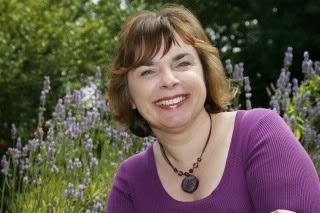 I am delighted to welcome Pippa Croft on the blog today to talk about her writing and her novel.
I am delighted to welcome Pippa Croft on the blog today to talk about her writing and her novel.
Hello Pippa. It is a pleasure to meet you today. Can you tell us a little about you?
I’m the daughter of a miner, the wife of an engineer and the mum of doctor... my daughter has just graduated as a PhD in May so I’m feeling very proud of her. I live in a small village in Staffordshire and I like reading, walking, swimming, body boarding and shopping.
What did you want to be when you were a child? Did you always know you wanted to write?
I didn’t know or want to be a novelist until I was about 42, which is mad really, because from as early as I can remember, I used to write. However, I didn’t write ‘stories’, I used to make up little brochures and booklets about places I’d been and facts I’d read and illustrate them. After I left Oxford, where I read English Lit, I worked as a copywriter and journalist until I finally decided to write my first piece of fan fiction, which was inspired by a TV drama called North and South.
Where do you get your ideas for your stories?
Everywhere. Inspiration can strike at any moment and rarely when I’m looking for it. Once you start writing fiction, you seem to unlock the gates of your subconscious to likely ideas and characters. The problem is, the gates can never be shut again.
I know the feeling! I sometimes think it's lucky nobody can see what goes on in my mind. When and where do you write? Do you have a special 'writing' time?
I try to keep office hours, which may be anytime from seven am to eight pm, and I work on Sundays quite often. I write in various rooms of the house so I don’t get bored or stuck in one chair.
What comes to you first, the characters or the plot?
Usually both, they tend to grow organically alongside each other.
What kind of man is Alexander, your hero?
Alexander is a darkly sexy and wealthy aristocrat, who is also a member of UKspecial forces – he’s been given a sabbatical from his unit to do a master’s at Oxford but that doesn’t stop him from disappearing off on ops from time to time! He seems to have it all, but under all the bravado, he’s a very troubled soul though he hates showing his feelings which causes anguish with his family and Lauren.
He sounds absolutely fascinating. What kind of woman is Lauren, your heroine?
Lauren is an American senator’s daughter. She’s smart and sassy, and adamant she won’t take any flak from anyone, least of all a bunch of snobby Brits. However, underneath it all, she feels like a fish out of water at Oxfordand she’s also nursing a broken heart at the start of the series. She’s determined to enjoy her year in Europe and avoid any entanglements, especially not with someone as dangerous as Alexander!
So, what did Alexander think the first time he saw Lauren?
He’s intrigued, annoyed, maddened and completely bowled over by his response to her. She’s sexy, feisty and very different to the type of woman he’s gone for before. When she refuses to fall into his arms – or bed – he can’t resist the challenge. What Alexander wants, Alexander gets... but he has no idea what he’s getting himself into!
And what did Lauren think the first time she saw Alexander?
Her physical reaction is instant and overwhelming – in fact, the sexual chemistry between them is so powerful, it terrifies her. She also thinks he’s arrogant, emotionally repressed, and to be avoided at all costs, but fending off Alexander is like trying to stop the tide.
THE SECOND TIME I SAW YOU is the second book in a series. How many books are you planning to write in this series and why did you choose to write a series of novels?
Three are planned so far – but you never know! The series has been inspired by my own student days at Oxford, and also by hearing all the stories my daughter shared me from her time there. I love writing passionate steamy stories about dark brooding alpha heroes and feisty women and I’ve been dying to write a book set at Oxford. This is my dream project!
Thank you so much Pippa for coming on the blog today, and good luck with THE SECOND TIME I SAW YOU! You can meet Pippa on
TwitterFacebookGoodreads
The First Time We Met is the first novel in the sizzling new Oxford Blue romance series from Pippa Croft. When US Senator’s daughter Lauren Cusack arrives at the enchanting Wyckham College of Oxford University, she hopes to mend her broken heart by throwing herself into her studies.
But then English aristocrat Alexander Hunt walks into her life and everything changes. Handsome, brooding, and with his own dark past to escape, Alexander is exactly what Lauren doesn’t need – but she finds herself helplessly drawn towards him.
Both Alexander and Lauren know that they should stay away from each other . . . but sometimes desire is so powerful that it conquers all else.


It's the beginning of a new term at Wyckham College, Oxford, and a fresh start for Lauren Cusack. Her fingers were badly burnt when a whirlwind romance with gorgeous English aristocrat, Alexander Hunt, became too hot to handle - and now she's determined to keep her distance.
Her resolve is shaken when Alexander appears on her doorstep - he's been completely torn apart by some devastating news. Lauren knows that she should stay away, but their chemistry is undeniable and she soon finds herself back in Alexander's arms.
Can Lauren handle the drama that comes with Alexander Hunt? Or will she have to sacrifice the most exhilarating passion she's ever known . . .
(THE SECOND TIME I SAW YOU you is the 2nd book in the Oxford Blue Series.)
About the Author
 I am delighted to welcome Pippa Croft on the blog today to talk about her writing and her novel.
I am delighted to welcome Pippa Croft on the blog today to talk about her writing and her novel.Hello Pippa. It is a pleasure to meet you today. Can you tell us a little about you?
I’m the daughter of a miner, the wife of an engineer and the mum of doctor... my daughter has just graduated as a PhD in May so I’m feeling very proud of her. I live in a small village in Staffordshire and I like reading, walking, swimming, body boarding and shopping.
What did you want to be when you were a child? Did you always know you wanted to write?
I didn’t know or want to be a novelist until I was about 42, which is mad really, because from as early as I can remember, I used to write. However, I didn’t write ‘stories’, I used to make up little brochures and booklets about places I’d been and facts I’d read and illustrate them. After I left Oxford, where I read English Lit, I worked as a copywriter and journalist until I finally decided to write my first piece of fan fiction, which was inspired by a TV drama called North and South.
Where do you get your ideas for your stories?
Everywhere. Inspiration can strike at any moment and rarely when I’m looking for it. Once you start writing fiction, you seem to unlock the gates of your subconscious to likely ideas and characters. The problem is, the gates can never be shut again.
I know the feeling! I sometimes think it's lucky nobody can see what goes on in my mind. When and where do you write? Do you have a special 'writing' time?
I try to keep office hours, which may be anytime from seven am to eight pm, and I work on Sundays quite often. I write in various rooms of the house so I don’t get bored or stuck in one chair.
What comes to you first, the characters or the plot?
Usually both, they tend to grow organically alongside each other.
What kind of man is Alexander, your hero?
Alexander is a darkly sexy and wealthy aristocrat, who is also a member of UKspecial forces – he’s been given a sabbatical from his unit to do a master’s at Oxford but that doesn’t stop him from disappearing off on ops from time to time! He seems to have it all, but under all the bravado, he’s a very troubled soul though he hates showing his feelings which causes anguish with his family and Lauren.
He sounds absolutely fascinating. What kind of woman is Lauren, your heroine?
Lauren is an American senator’s daughter. She’s smart and sassy, and adamant she won’t take any flak from anyone, least of all a bunch of snobby Brits. However, underneath it all, she feels like a fish out of water at Oxfordand she’s also nursing a broken heart at the start of the series. She’s determined to enjoy her year in Europe and avoid any entanglements, especially not with someone as dangerous as Alexander!
So, what did Alexander think the first time he saw Lauren?
He’s intrigued, annoyed, maddened and completely bowled over by his response to her. She’s sexy, feisty and very different to the type of woman he’s gone for before. When she refuses to fall into his arms – or bed – he can’t resist the challenge. What Alexander wants, Alexander gets... but he has no idea what he’s getting himself into!
And what did Lauren think the first time she saw Alexander?
Her physical reaction is instant and overwhelming – in fact, the sexual chemistry between them is so powerful, it terrifies her. She also thinks he’s arrogant, emotionally repressed, and to be avoided at all costs, but fending off Alexander is like trying to stop the tide.
THE SECOND TIME I SAW YOU is the second book in a series. How many books are you planning to write in this series and why did you choose to write a series of novels?
Three are planned so far – but you never know! The series has been inspired by my own student days at Oxford, and also by hearing all the stories my daughter shared me from her time there. I love writing passionate steamy stories about dark brooding alpha heroes and feisty women and I’ve been dying to write a book set at Oxford. This is my dream project!
Thank you so much Pippa for coming on the blog today, and good luck with THE SECOND TIME I SAW YOU! You can meet Pippa on
TwitterFacebookGoodreads
The First Time We Met is the first novel in the sizzling new Oxford Blue romance series from Pippa Croft. When US Senator’s daughter Lauren Cusack arrives at the enchanting Wyckham College of Oxford University, she hopes to mend her broken heart by throwing herself into her studies.
But then English aristocrat Alexander Hunt walks into her life and everything changes. Handsome, brooding, and with his own dark past to escape, Alexander is exactly what Lauren doesn’t need – but she finds herself helplessly drawn towards him.
Both Alexander and Lauren know that they should stay away from each other . . . but sometimes desire is so powerful that it conquers all else.

Published on May 30, 2014 00:00
May 11, 2014
'Meet My Main Character' Blog Tour - THE LADY OF BELLEFONTAINE
Thank you very much Diane M Denton for tagging me and suggesting I take part in this fun blog tour. I have just signed a publishing contract with Áccent Press for my contemporary romantic suspense THE LADY OF BELLEFONTAINE so this is the novel I will be talking about today.
1. What is the name of your character? Is she a fictional person?My heroin is called Amy Carter and she is totally fictional.
2. Where is the story set?THE LADY OF BELLEFONTAINE is set in a hill top village in the beautiful Lubéron region of Provence, in the South of France. This part of Franceis absolutely breathtaking, with golden stone farmhouses - 'bastides'- villages and little towns surrounded by orchards, vineyards and forests. And of course, lovely old fountains, which were the inspiration for the story.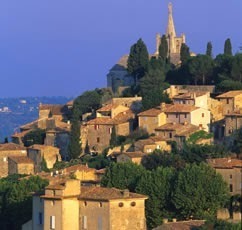
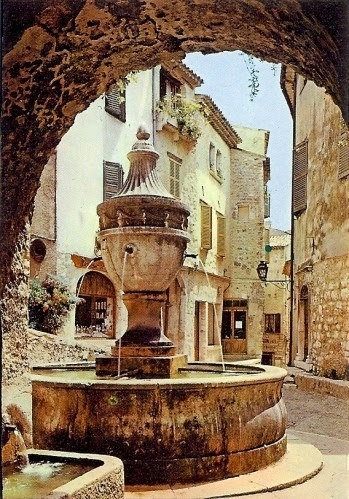 3. What should we know about your heroine?After being made redundant from the UK bank where she used to work as a translator, Amy decides to follow her dream and start a new life. She buys a very old 'bastide' called Bellefontaine she plans to turn into a guesthouse.
3. What should we know about your heroine?After being made redundant from the UK bank where she used to work as a translator, Amy decides to follow her dream and start a new life. She buys a very old 'bastide' called Bellefontaine she plans to turn into a guesthouse.
4. What is the main conflict?After a series of unsettling and downright scary incidents, Amy realises that her arrival at Bellefontaine isn't welcome by everybody in the village.
The romantic conflict of the novel is her stormy relationship with Fabien Coste, the aristocratic owner of nearby luxury hotel Manoir Coste. Despite finding an ancient love spell that binds the ladies of Bellefontaine to the ducs de Coste, Amy has no intention of falling in love with Fabien...But how long will she resist his dark, enigmatic charm?
5. What is the personal goal of the character?Although she knows nothing of the hospitality industry, Amy is determined to set up and run a successful guest house. She is a fast learner and a hard worker, and isn't easily discouraged even if Fabien mocks her naive and at times 'hippyish' ideas. This is her big chance, her dream come true. When she discovers that Bellefontaine has a sinister past and that it was for centuries linked to the bloodthirsty cult of a local Gallic goddess, she doesn't run away but resolves to find out more and unmask those who put her life in danger.
6. Is there a working title for this novel, and can we read more about it?The working title is THE LADY OF BELLEFONTAINE. I can only at this very early stage post the provisional blurb for the novel. Here is it below.
'The spell flows with the spring, binding hearts together until death tears them apart.' This is what a Latin inscription says on an ancient stone Amy Carter finds in the overgrown garden of the farmhouse she just moved into. If Amy has big plans for Bellefontaine and her new life in Provence, none of them involves falling in love - least of all with Fabien Coste, the handsome but arrogant owner of nearby Manoir Coste, the ancestral family chateau he turned into a luxury hotel.
Yet local legends talk about past romantic entanglements between the ladies of Bellefontaine and the ducs de Coste, and despite herself Amy soon finds herself falling in love with Fabien. As springtime turns Bellefontaine into the paradise she always dreamt of, Amy discovers that her home is at the centre of a mystery involving the evil cult of an ancient Gallic goddess, and that it isn't only her heart which is in terrible danger, but her life too. Can she trust Fabien to help solve Bellefontaine's dark mystery? Is he genuinely attracted to her or does he have his own motives for wanting to keep her close? And will the love spell between them turn out to be a deadly curse?
I can't resist posting the photo of another fountain!
7. When can we expect the book to be published?I only just signed the contract with Áccent Press, so I cannot at this stage say when the book will be published.
Thank you again Diane for tagging me. I hope you found the interview interesting and would love to read comments and answer questions!
Diane Denton can be found at http://bardessdmdenton.wordpress.com/...
1. What is the name of your character? Is she a fictional person?My heroin is called Amy Carter and she is totally fictional.
2. Where is the story set?THE LADY OF BELLEFONTAINE is set in a hill top village in the beautiful Lubéron region of Provence, in the South of France. This part of Franceis absolutely breathtaking, with golden stone farmhouses - 'bastides'- villages and little towns surrounded by orchards, vineyards and forests. And of course, lovely old fountains, which were the inspiration for the story.

 3. What should we know about your heroine?After being made redundant from the UK bank where she used to work as a translator, Amy decides to follow her dream and start a new life. She buys a very old 'bastide' called Bellefontaine she plans to turn into a guesthouse.
3. What should we know about your heroine?After being made redundant from the UK bank where she used to work as a translator, Amy decides to follow her dream and start a new life. She buys a very old 'bastide' called Bellefontaine she plans to turn into a guesthouse. 4. What is the main conflict?After a series of unsettling and downright scary incidents, Amy realises that her arrival at Bellefontaine isn't welcome by everybody in the village.
The romantic conflict of the novel is her stormy relationship with Fabien Coste, the aristocratic owner of nearby luxury hotel Manoir Coste. Despite finding an ancient love spell that binds the ladies of Bellefontaine to the ducs de Coste, Amy has no intention of falling in love with Fabien...But how long will she resist his dark, enigmatic charm?
5. What is the personal goal of the character?Although she knows nothing of the hospitality industry, Amy is determined to set up and run a successful guest house. She is a fast learner and a hard worker, and isn't easily discouraged even if Fabien mocks her naive and at times 'hippyish' ideas. This is her big chance, her dream come true. When she discovers that Bellefontaine has a sinister past and that it was for centuries linked to the bloodthirsty cult of a local Gallic goddess, she doesn't run away but resolves to find out more and unmask those who put her life in danger.
6. Is there a working title for this novel, and can we read more about it?The working title is THE LADY OF BELLEFONTAINE. I can only at this very early stage post the provisional blurb for the novel. Here is it below.
'The spell flows with the spring, binding hearts together until death tears them apart.' This is what a Latin inscription says on an ancient stone Amy Carter finds in the overgrown garden of the farmhouse she just moved into. If Amy has big plans for Bellefontaine and her new life in Provence, none of them involves falling in love - least of all with Fabien Coste, the handsome but arrogant owner of nearby Manoir Coste, the ancestral family chateau he turned into a luxury hotel.
Yet local legends talk about past romantic entanglements between the ladies of Bellefontaine and the ducs de Coste, and despite herself Amy soon finds herself falling in love with Fabien. As springtime turns Bellefontaine into the paradise she always dreamt of, Amy discovers that her home is at the centre of a mystery involving the evil cult of an ancient Gallic goddess, and that it isn't only her heart which is in terrible danger, but her life too. Can she trust Fabien to help solve Bellefontaine's dark mystery? Is he genuinely attracted to her or does he have his own motives for wanting to keep her close? And will the love spell between them turn out to be a deadly curse?
I can't resist posting the photo of another fountain!

7. When can we expect the book to be published?I only just signed the contract with Áccent Press, so I cannot at this stage say when the book will be published.
Thank you again Diane for tagging me. I hope you found the interview interesting and would love to read comments and answer questions!
Diane Denton can be found at http://bardessdmdenton.wordpress.com/...
Published on May 11, 2014 13:45
April 26, 2014
Promo Blitz: The Other Side of Morning by Jo Lambert
Today it is my pleasure to host Jo Lambert and her latest novel The Other Side of Morning.

Born and raised in rural Wiltshire, Jo Lambert grew up with a love of books and a vivid imagination. As a child she enjoyed creating her own adventure stories similar to Enid Blyton’s Famous Five. Writing always stayed with her, but college, work and eventually marriage found it kept very much in the background as a hobby. In 2009 everything changed when she decided to self-publish a novel she had completed. After When Tomorrow Comes, three other books - Love Lies and Promises, The Ghost of You and Me and Between Today and Yesterday followed. In 2013 she decided to give up full time work to concentrate fully on her writing. Her fifth novel The Other Side of Morning was accepted by ThornBerry Publishing UK and is now available in e-book form with a paperback version to follow shortly.
Jo is married and lives in a village on the eastern edge of Bath, Somerset with one small grey feline called Mollie. She shares her husband with his ‘other woman’ Bridget - a 48 year old white MG Midget who keeps him occupied while she is busy writing.

Book Blurb
Charlotte Kendrick’s ill-fated relationship with rock star Christian Rosetti still haunts her. The new man in her life, handsome, rich Italian restaurateur Marco D’Alesandro, is everything she wants. But when beautiful heiress Rossana Caravello arrives to spend time with his family as their house guest she wonders whether history is about to repeat itself. Marco insists he loves her and that he has no interest in their guest, but how can Charlotte believe him when everything about his behaviour around Rossana indicates he is lying? Giving him the benefit of the doubt, Charlottewonders whether his ruthless stepmother Thérèse may be involved, and decides to find out more about the young heiress. However, far from putting her mind at rest, what she discovers leaves her feeling more unsettled than ever about her future with Marco…
From rural West Somerset to the glorious rolling landscape of Tuscany and the Italian lakes THE OTHER SIDE OF MORNING is a story of love, betrayal, deception and ultimate sacrifice.
My Review In THE OTHER SIDE OF Morning, Jo Lambert takes the story of the evil step-mother to new heights. Wealthy, glamorous Thérèse is determined to put an end to the budding relationship between her stepson Marco and kind, clever and unassuming Charlotte Kendrick, and it seems will stop at nothing to push naive Italian heiress Rossana into his arms and his bed. The love story between Marco, who owns of one of London's most exclusive restaurants, and Charlotte - still recovering from her failed love affair with rockstar Christian Rosetti - seems doomed from the start.
As we follow them from beautiful rural Somerset to glamorous London or again Tuscany and France through a series of incidents and sometimes frustrating misunderstandings, we can only hope evil Thérèse gets her comeuppance and love prevails in the end.
Jo Lambert also creates an impressive cast of characters who develop throughout the story, the most memorable for me being tormented rock star Christian Rosetti and dangerously unhinged Kayte.
Altogether I found THE OTHER SIDE OF MORNING a very enjoyable read.
You can find it here:
http://www.amazon.co.uk/The-Other-Sid...

Born and raised in rural Wiltshire, Jo Lambert grew up with a love of books and a vivid imagination. As a child she enjoyed creating her own adventure stories similar to Enid Blyton’s Famous Five. Writing always stayed with her, but college, work and eventually marriage found it kept very much in the background as a hobby. In 2009 everything changed when she decided to self-publish a novel she had completed. After When Tomorrow Comes, three other books - Love Lies and Promises, The Ghost of You and Me and Between Today and Yesterday followed. In 2013 she decided to give up full time work to concentrate fully on her writing. Her fifth novel The Other Side of Morning was accepted by ThornBerry Publishing UK and is now available in e-book form with a paperback version to follow shortly.
Jo is married and lives in a village on the eastern edge of Bath, Somerset with one small grey feline called Mollie. She shares her husband with his ‘other woman’ Bridget - a 48 year old white MG Midget who keeps him occupied while she is busy writing.

Book Blurb
Charlotte Kendrick’s ill-fated relationship with rock star Christian Rosetti still haunts her. The new man in her life, handsome, rich Italian restaurateur Marco D’Alesandro, is everything she wants. But when beautiful heiress Rossana Caravello arrives to spend time with his family as their house guest she wonders whether history is about to repeat itself. Marco insists he loves her and that he has no interest in their guest, but how can Charlotte believe him when everything about his behaviour around Rossana indicates he is lying? Giving him the benefit of the doubt, Charlottewonders whether his ruthless stepmother Thérèse may be involved, and decides to find out more about the young heiress. However, far from putting her mind at rest, what she discovers leaves her feeling more unsettled than ever about her future with Marco…
From rural West Somerset to the glorious rolling landscape of Tuscany and the Italian lakes THE OTHER SIDE OF MORNING is a story of love, betrayal, deception and ultimate sacrifice.
My Review In THE OTHER SIDE OF Morning, Jo Lambert takes the story of the evil step-mother to new heights. Wealthy, glamorous Thérèse is determined to put an end to the budding relationship between her stepson Marco and kind, clever and unassuming Charlotte Kendrick, and it seems will stop at nothing to push naive Italian heiress Rossana into his arms and his bed. The love story between Marco, who owns of one of London's most exclusive restaurants, and Charlotte - still recovering from her failed love affair with rockstar Christian Rosetti - seems doomed from the start.
As we follow them from beautiful rural Somerset to glamorous London or again Tuscany and France through a series of incidents and sometimes frustrating misunderstandings, we can only hope evil Thérèse gets her comeuppance and love prevails in the end.
Jo Lambert also creates an impressive cast of characters who develop throughout the story, the most memorable for me being tormented rock star Christian Rosetti and dangerously unhinged Kayte.
Altogether I found THE OTHER SIDE OF MORNING a very enjoyable read.
You can find it here:
http://www.amazon.co.uk/The-Other-Sid...
Published on April 26, 2014 00:00
April 15, 2014
A recipe for the 'Mouna', a traditional Easter brioche from North Africa
My mother was born and brought up near Algiersin North Africa, where Easter Monday was celebrated with a family picnic and the sharing of the 'Mouna', a traditional Easter brioche. Even long after leaving Algeria, she still baked a Mouna for our family and the smell of the brioche baking in the oven - a blend of citrus fruit and aniseed - was absolutely divine.

Where does the name Mouna come from? Nobody really knows. Some claim that is originates from Spainwhere a similar brioche called 'Mona de Pascua' is baked for Easter Monday. Others associate it with Fort Lamoune near the Algerian town of Oran. The fort was built by the Spanish in the seventeenth century and called Fort Lamoune (or Castillo de la Mona) because lots of monkeys lived in the area, and in Spanish, monkey is 'mona'. The families of the men imprisoned in Fort Lamounecould only visit them once a year, on Easter Monday, and used to bring them sweet bread loaves. Another explanation is that the Mimouna is the last day of the Jewish Easter and that it was traditional on that day for Jewish families from Algiersand other North-African towns to spend the day outside, in parks and forests - and have a picnic.

Whatever its origins, the Mouna is delicious, if a little denser than other brioches.
Ingredients for 4 small Mounas. (You would traditionally bake four Mounas, one for you and your family, one for relatives, the others for friends and neighbours.)1 kg flour300 g sugar75 g butter5 eggs1 sachet yeast 6 large spoonfuls of oilthe zest of one lemonthe zest of one orangethe juice of one orangea few aniseeds (optional)
Preparation 30 minutes - 2 to 3 hours for the dough to rise - 30 minutes to bake
1. Pre-heat the oven at 100°C (th.3/4).2. Mix the sugar, eggs, lemon and orange zests until the mixture is pale and fluffy. Add the melted butter and the oil and mix well. If you have aniseeds, you can add them to the mixture now.3. Now mix in the sachet of yeast into the flour, and add bit by bit to the rest of the mixture, working the dough until you can roll it into a soft ball. Cover with a tea towel.4. Switch the oven off and put the dough (covered with the tea towel) inside for 2 to 3 hours.6. Take the dough out of the oven, and knead it until it's soft and does not stick.7. Make 4 balls. With a sharp knife cut a few lines on top of each ball, then brush egg yolk on top and sprinkle sugar (traditionally you crush sugar lumps or cubes but you can't really find them in England). Leave for 15 min before putting in the oven.8. Bake for 20 min at 210°C (th.7) then switch the oven off and leave for a further 10 minutes.
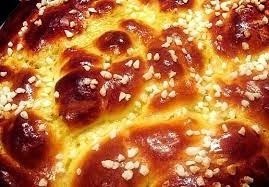
My family was truly multicultural. Just before biting into my mother North-African Mouna for breakfast, we would be submitted to the Polish 'dyngus' by my father! For those who don't know, it's the tradition to throw water at people on Easter Monday (which can vary from a weak sprinkling to a thorough soaking).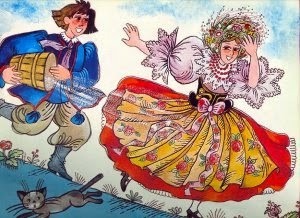
Joyeuses Pâques!

Where does the name Mouna come from? Nobody really knows. Some claim that is originates from Spainwhere a similar brioche called 'Mona de Pascua' is baked for Easter Monday. Others associate it with Fort Lamoune near the Algerian town of Oran. The fort was built by the Spanish in the seventeenth century and called Fort Lamoune (or Castillo de la Mona) because lots of monkeys lived in the area, and in Spanish, monkey is 'mona'. The families of the men imprisoned in Fort Lamounecould only visit them once a year, on Easter Monday, and used to bring them sweet bread loaves. Another explanation is that the Mimouna is the last day of the Jewish Easter and that it was traditional on that day for Jewish families from Algiersand other North-African towns to spend the day outside, in parks and forests - and have a picnic.

Whatever its origins, the Mouna is delicious, if a little denser than other brioches.
Ingredients for 4 small Mounas. (You would traditionally bake four Mounas, one for you and your family, one for relatives, the others for friends and neighbours.)1 kg flour300 g sugar75 g butter5 eggs1 sachet yeast 6 large spoonfuls of oilthe zest of one lemonthe zest of one orangethe juice of one orangea few aniseeds (optional)
Preparation 30 minutes - 2 to 3 hours for the dough to rise - 30 minutes to bake
1. Pre-heat the oven at 100°C (th.3/4).2. Mix the sugar, eggs, lemon and orange zests until the mixture is pale and fluffy. Add the melted butter and the oil and mix well. If you have aniseeds, you can add them to the mixture now.3. Now mix in the sachet of yeast into the flour, and add bit by bit to the rest of the mixture, working the dough until you can roll it into a soft ball. Cover with a tea towel.4. Switch the oven off and put the dough (covered with the tea towel) inside for 2 to 3 hours.6. Take the dough out of the oven, and knead it until it's soft and does not stick.7. Make 4 balls. With a sharp knife cut a few lines on top of each ball, then brush egg yolk on top and sprinkle sugar (traditionally you crush sugar lumps or cubes but you can't really find them in England). Leave for 15 min before putting in the oven.8. Bake for 20 min at 210°C (th.7) then switch the oven off and leave for a further 10 minutes.

My family was truly multicultural. Just before biting into my mother North-African Mouna for breakfast, we would be submitted to the Polish 'dyngus' by my father! For those who don't know, it's the tradition to throw water at people on Easter Monday (which can vary from a weak sprinkling to a thorough soaking).

Joyeuses Pâques!
Published on April 15, 2014 05:19
April 6, 2014
Liebster Blog Award
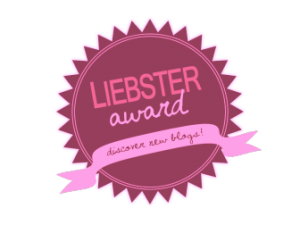 Author Katie L. Carroll nominated me, and several other fellow authors, for a Liebster Blog Award. I must confess I had never heard of it before but it sounds like a really great idea.
Author Katie L. Carroll nominated me, and several other fellow authors, for a Liebster Blog Award. I must confess I had never heard of it before but it sounds like a really great idea.The Liebster Blog Award translates to “the beloved” or “the dearest.” The award is given as a way to celebrate smaller blogs. (Only blogs with under 200 followers can be awarded.) Before you accept the award, there are a certain set of tasks you must complete. The first is to reveal 11 facts about you, answer the 11 questions asked by the blogger who nominated you, and then create 11 questions for the bloggers you nominate to answer on their own blog.
So here are my 11 facts:
1. Napoleon stopped over in my village near Lyon on his way back from his exile on Elba during what is known as 'The 100 days'. I always wanted to go inside never dared ask.
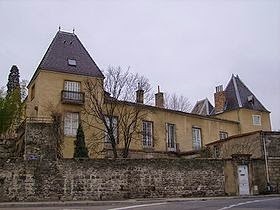 Château de Saint-Genis-Laval2. My first dog was a horrible, smelly stray. I was six years old and named him 'Peanut Bottle of Rum' (Cacahuète Bouteille de Rhum in French). I don't remember why. I never liked peanuts and I had of course never drunk a drop of rum!
Château de Saint-Genis-Laval2. My first dog was a horrible, smelly stray. I was six years old and named him 'Peanut Bottle of Rum' (Cacahuète Bouteille de Rhum in French). I don't remember why. I never liked peanuts and I had of course never drunk a drop of rum!3. We were three girls (still are) in my family. I wanted an older brother so badly I made one up and kept the pretence for over two years in my primary school. I had named him Stanislas (which was my Polish grandfather's name).
4. In fact, I was always one for making up stories and inventing people. My best friend Nathalie and I invented an imaginary friend, Josephine, and were so convincing people still ask about her to this day.
5. I must have a touch of OCD because I can't stand it when things aren't straight or symmetrical. My students at school are very good about it and always make sure desks and chairs are straight before I even need to say anything!
6. I've had the same vivid, recurring dream about a haunted chateau and its inhabitants since I was a little girl. There is this dark room I am not to go in. After all these years of dreaming about the place, I still haven't plucked up the courage to open the door. It looks something like this...
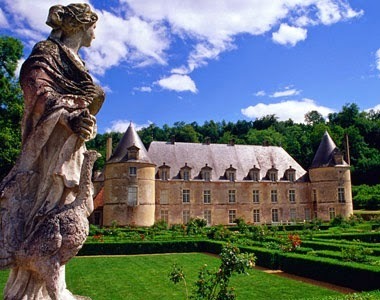 7. I stammer when I'm tired, which is pretty much all the time these days.
7. I stammer when I'm tired, which is pretty much all the time these days.8. I used to have a fantastic photographic memory and got through four years of law school by memorising pages and pages of legal documents, dates, numbers and facts and regurgitating them the day of the exam. I always felt like a fraud because of it.
9. I could happily live on goat cheese, crusty bread, cake...and black coffee.

10. I went to my first Romantic Novelist Association conference last July. During the train journey to Sheffield, I chatted to a very interesting guy and for the first time ever I introduced myself as a writer. It felt incredible.
11. I love the process of finding my characters' name. En vrac, the heroins of my next four novels will be called Celeste, Venetia, Gisèle and Prudence.
And now, here are the questions Katie asked me to answer.
1. What do you like best about your personality?
I'm not sure there is anything to like, really. I'm a perfectionist, and very hard working!
2. What is the best piece of advice you ever received?
A French saying: Qui ne tente rien n'a rien. (Who dares not, gets nothing...would that be right?)
3. What does it take for a book to stay with you long after reading it?
The characters must be true, feel real and create strong emotions inside me.
4. If you could tell an author that you admire one thing, what would it be?
That their book made me laugh, and cry, and dream, and I wanted to magically sneak into it!
5. Who is the one person who always makes you happy? (I have to change this to 'persons')
My three children - two boys and a girl. They are infuriating, fun, adorable, thoughtful and a bit loopy!
6. What was the best birthday you ever had?
Every single birthday is lovely and special.
7. What drives you to share your thoughts about books on social media?
I like writing about the books I enjoyed reading, and I love exchanging ideas and tips with fellow authors.
8. What is the best thing an author ever said to you?
To write and rewrite, and then rewrite again.
9. What do you consider the ideal length for a book in terms of the number of pages?
I'm not sure there is an ideal length. It all depends on the story and the characters. Some take longer to develop, I suppose.
10. What fictional character do you most resemble?
Marie-Ange, from my debut historical romance ANGEL HEART.
11. If you could give the person who reads this an uplifting message, what would it be?
There is joy and love and wonder everywhere around you. Just open your eyes and your heart.
The time has come to nominate another blogger for the Liebster Blog Award. If you would like to take part, please leave a comment! I will reply and tell you what to do to enter.
It was the talented Katie L. Carroll who nominated me. You can find her and her great books at http://www.katielcarroll.com/the-lieb...
Published on April 06, 2014 13:37
March 24, 2014
Auction of Napoleon's last shirt in Paris
Several items of clothing and personal belongings of Napoleon Bonaparte were due to be auctioned last Sunday in Paris at Maison Orsenat.
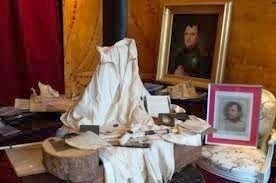 Among them were a cambric shirt worn by the emperor the day before he died (estimated at between 30000 and 40 000 euros), a lock of hair cut the day of his death (which may fetch between 3 000 and 5 000 euros), bandages and two handkerchiefs. The items were collected by the emperor's servant, Achille Archambault, but their ownership is now disputed and the auction was postponed in order to enable the courts to establish the identity of the rightful owner.
Among them were a cambric shirt worn by the emperor the day before he died (estimated at between 30000 and 40 000 euros), a lock of hair cut the day of his death (which may fetch between 3 000 and 5 000 euros), bandages and two handkerchiefs. The items were collected by the emperor's servant, Achille Archambault, but their ownership is now disputed and the auction was postponed in order to enable the courts to establish the identity of the rightful owner.
I always find it fascinating - if a little macabre - to be able to see for myself personal items which have belonged to a historical figure, writer or actor, but I'm really not sure I would ever put a bid in for any of them, even if I had the money. I think they should really belong in a museum, not in the hands of a private collector.
Napoleon died at Longwood on the island of St Helena on May 5th 1821 after a six year long exile. A striking, desolate mass of rugged rocks St Helena is located in the middle of the South Atlantic ocean with the nearest land six hundred miles away. Wathen, T.E. A Series of Views Illustrative of the Island of St. Helena. Clay, London, 1821. Napoleon first stayed at Briars Pavillion on the island then moved into Longwood, a two-stories house in a cold, windy and damp part of the island. Although the British government recognised the inadequacy of Longwood as the former emperor's residence, it was deemed the safest place for him. Sir Hudson Lowe, the island's governor, was indeed haunted by the fear that Napoleon should escape and behaved like a jailer toward him, ordering that his correspondence and newspapers be censured, and even forbidding the former emperor any news from his wife Marie-Louise and their son. In fact relationships between Napoleon and Lowe were so bad they only met six times during Napoleon's exile and the former French emperor is said to have complained to his physician O'Meara that Lowe has such a 'horrid countenance' he feared he had the evil eye and had poisoned his cup of coffee just by looking at it!
Wathen, T.E. A Series of Views Illustrative of the Island of St. Helena. Clay, London, 1821. Napoleon first stayed at Briars Pavillion on the island then moved into Longwood, a two-stories house in a cold, windy and damp part of the island. Although the British government recognised the inadequacy of Longwood as the former emperor's residence, it was deemed the safest place for him. Sir Hudson Lowe, the island's governor, was indeed haunted by the fear that Napoleon should escape and behaved like a jailer toward him, ordering that his correspondence and newspapers be censured, and even forbidding the former emperor any news from his wife Marie-Louise and their son. In fact relationships between Napoleon and Lowe were so bad they only met six times during Napoleon's exile and the former French emperor is said to have complained to his physician O'Meara that Lowe has such a 'horrid countenance' he feared he had the evil eye and had poisoned his cup of coffee just by looking at it!
 Wathen, T.E. A Series of Views Illustrative of the Island of St. Helena. Clay, London, 1821. Longwood was designed in a cottage style and contained twenty-four rooms, with Bonaparte occupying the right wing. In an illustrated book published in 1821, T.E. Wathen gives a striking description of the desolate, rocky island and of Longwood House and the rooms allocated to the defeated French emperor.
Wathen, T.E. A Series of Views Illustrative of the Island of St. Helena. Clay, London, 1821. Longwood was designed in a cottage style and contained twenty-four rooms, with Bonaparte occupying the right wing. In an illustrated book published in 1821, T.E. Wathen gives a striking description of the desolate, rocky island and of Longwood House and the rooms allocated to the defeated French emperor.
The drawing-room was coloured 'various shades of green and arabesque gold panels, with curtains of light silk taboret, of Pomonagreen, and velvet borders edged with gold coloured silk twist'. Wathen even describes some of the furnishing: a carpet of 'various shades of brown, olive, and amber; an elegant oak centre table; pier table, inlaid with a slab of Verd Antique Mona marble; splendid pier glass, with a frame of Buhl and ebony; chairs of British oak; two Greek sofas and footstools ornamented with Or Moulu; a piano forte; and chandeliers and candelabri to light the apartment.'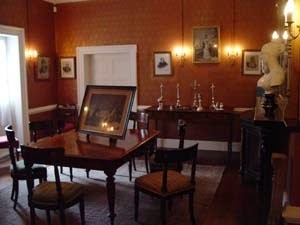 Thanks to Wathen we know that next to the dining-room was a library, which was 'furnished in the Etruscan style, with several dwarf book-cases' and desks and that the sitting-room was 'ornamented with an ethereal blue carpet shaded with black, and several ebony cabinets inlaid with brass'. The emperor's bedroom featured a high canopy 'bedstead, enclosing a silken mosquito net, and hung with furniture of lilac Persian edged with gold coloured fringe.'
Thanks to Wathen we know that next to the dining-room was a library, which was 'furnished in the Etruscan style, with several dwarf book-cases' and desks and that the sitting-room was 'ornamented with an ethereal blue carpet shaded with black, and several ebony cabinets inlaid with brass'. The emperor's bedroom featured a high canopy 'bedstead, enclosing a silken mosquito net, and hung with furniture of lilac Persian edged with gold coloured fringe.'
 In the bathroom was a tub was lined with marble 'made to admit hot or cold water'.
In the bathroom was a tub was lined with marble 'made to admit hot or cold water'.
 The other wing of Longwood House contained spacious apartments for Bonaparte's suite, with servant's offices and store-rooms in the rear and the kitchen was located in a separate building.
The other wing of Longwood House contained spacious apartments for Bonaparte's suite, with servant's offices and store-rooms in the rear and the kitchen was located in a separate building.
Before Napoleon's funeral, which took place on May 9 1821, one hundred men were made to cut a path directly to the burial site the emperor himself had chosen shortly after his arrival on the island for its proximity to willow trees and a spring - a place called Devil's Punch Bowl. At the time of Wathen's visit to St Helena, a sentinel constantly guarded the grave.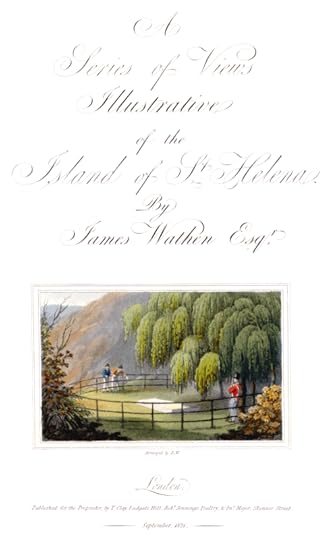 Wathen, T.E. A Series of Views Illustrative of the Island of St. Helena. Clay, London, 1821. Napoleon's remains were removed in 1840 and shipped to Paris where they were buried with full military honours in a marble casket in the Hotel des Invalides on December 15 1840. Despite the biting cold the crowds were huge along the avenues where the military cortege passed, so much so that the government feared a revolutionary outbreak.
Wathen, T.E. A Series of Views Illustrative of the Island of St. Helena. Clay, London, 1821. Napoleon's remains were removed in 1840 and shipped to Paris where they were buried with full military honours in a marble casket in the Hotel des Invalides on December 15 1840. Despite the biting cold the crowds were huge along the avenues where the military cortege passed, so much so that the government feared a revolutionary outbreak.
Victor Hugo wrote about that memorable day
'O frozen sky! and sunlight pure! shining bright in history!
Funereal triumph, imperial torch!Let the people's memory hold you forever, Day beautiful as glory,Cold as the tomb'
("Ciel glacé ! soleil pur ! Oh ! brille dans l’histoire ! / Du funèbre triomphe, impérial flambeau ! / Que le peuple à jamais te garde en sa mémoire / Jour beau comme la gloire, / Froid comme le tombeau." - Victor Hugo, Les Rayons et les Ombres, 1840.)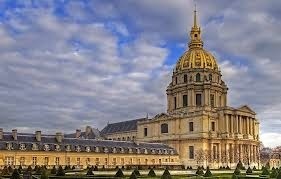 Only government officials and military personnel were allowed at the ceremony itself, and many French were angry that they had not been able to pay their respects properly to the man they had come to consider as a martyr. Worse still for the government, many people still believed that Napoleon had not died on St Helena, that the commission sent to retrieve his remains had found only an empty coffin and rumour spread that the tomb at Les Invalides was only a cenotaph.
Only government officials and military personnel were allowed at the ceremony itself, and many French were angry that they had not been able to pay their respects properly to the man they had come to consider as a martyr. Worse still for the government, many people still believed that Napoleon had not died on St Helena, that the commission sent to retrieve his remains had found only an empty coffin and rumour spread that the tomb at Les Invalides was only a cenotaph.
Napoleon's remains repose today beneath the dome in the Invalides, in a monument designed by architect Louis Visconti in 1842, but which was only completed in 1861.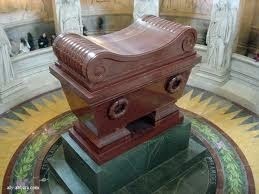 So what will become of Napoleon's last belongings - a shirt, a lock of hair, a couple of handkerchiefs? Time, and the French courts, will tell...
So what will become of Napoleon's last belongings - a shirt, a lock of hair, a couple of handkerchiefs? Time, and the French courts, will tell...
 Among them were a cambric shirt worn by the emperor the day before he died (estimated at between 30000 and 40 000 euros), a lock of hair cut the day of his death (which may fetch between 3 000 and 5 000 euros), bandages and two handkerchiefs. The items were collected by the emperor's servant, Achille Archambault, but their ownership is now disputed and the auction was postponed in order to enable the courts to establish the identity of the rightful owner.
Among them were a cambric shirt worn by the emperor the day before he died (estimated at between 30000 and 40 000 euros), a lock of hair cut the day of his death (which may fetch between 3 000 and 5 000 euros), bandages and two handkerchiefs. The items were collected by the emperor's servant, Achille Archambault, but their ownership is now disputed and the auction was postponed in order to enable the courts to establish the identity of the rightful owner.I always find it fascinating - if a little macabre - to be able to see for myself personal items which have belonged to a historical figure, writer or actor, but I'm really not sure I would ever put a bid in for any of them, even if I had the money. I think they should really belong in a museum, not in the hands of a private collector.
Napoleon died at Longwood on the island of St Helena on May 5th 1821 after a six year long exile. A striking, desolate mass of rugged rocks St Helena is located in the middle of the South Atlantic ocean with the nearest land six hundred miles away.
 Wathen, T.E. A Series of Views Illustrative of the Island of St. Helena. Clay, London, 1821. Napoleon first stayed at Briars Pavillion on the island then moved into Longwood, a two-stories house in a cold, windy and damp part of the island. Although the British government recognised the inadequacy of Longwood as the former emperor's residence, it was deemed the safest place for him. Sir Hudson Lowe, the island's governor, was indeed haunted by the fear that Napoleon should escape and behaved like a jailer toward him, ordering that his correspondence and newspapers be censured, and even forbidding the former emperor any news from his wife Marie-Louise and their son. In fact relationships between Napoleon and Lowe were so bad they only met six times during Napoleon's exile and the former French emperor is said to have complained to his physician O'Meara that Lowe has such a 'horrid countenance' he feared he had the evil eye and had poisoned his cup of coffee just by looking at it!
Wathen, T.E. A Series of Views Illustrative of the Island of St. Helena. Clay, London, 1821. Napoleon first stayed at Briars Pavillion on the island then moved into Longwood, a two-stories house in a cold, windy and damp part of the island. Although the British government recognised the inadequacy of Longwood as the former emperor's residence, it was deemed the safest place for him. Sir Hudson Lowe, the island's governor, was indeed haunted by the fear that Napoleon should escape and behaved like a jailer toward him, ordering that his correspondence and newspapers be censured, and even forbidding the former emperor any news from his wife Marie-Louise and their son. In fact relationships between Napoleon and Lowe were so bad they only met six times during Napoleon's exile and the former French emperor is said to have complained to his physician O'Meara that Lowe has such a 'horrid countenance' he feared he had the evil eye and had poisoned his cup of coffee just by looking at it!
 Wathen, T.E. A Series of Views Illustrative of the Island of St. Helena. Clay, London, 1821. Longwood was designed in a cottage style and contained twenty-four rooms, with Bonaparte occupying the right wing. In an illustrated book published in 1821, T.E. Wathen gives a striking description of the desolate, rocky island and of Longwood House and the rooms allocated to the defeated French emperor.
Wathen, T.E. A Series of Views Illustrative of the Island of St. Helena. Clay, London, 1821. Longwood was designed in a cottage style and contained twenty-four rooms, with Bonaparte occupying the right wing. In an illustrated book published in 1821, T.E. Wathen gives a striking description of the desolate, rocky island and of Longwood House and the rooms allocated to the defeated French emperor. The drawing-room was coloured 'various shades of green and arabesque gold panels, with curtains of light silk taboret, of Pomonagreen, and velvet borders edged with gold coloured silk twist'. Wathen even describes some of the furnishing: a carpet of 'various shades of brown, olive, and amber; an elegant oak centre table; pier table, inlaid with a slab of Verd Antique Mona marble; splendid pier glass, with a frame of Buhl and ebony; chairs of British oak; two Greek sofas and footstools ornamented with Or Moulu; a piano forte; and chandeliers and candelabri to light the apartment.'
 Thanks to Wathen we know that next to the dining-room was a library, which was 'furnished in the Etruscan style, with several dwarf book-cases' and desks and that the sitting-room was 'ornamented with an ethereal blue carpet shaded with black, and several ebony cabinets inlaid with brass'. The emperor's bedroom featured a high canopy 'bedstead, enclosing a silken mosquito net, and hung with furniture of lilac Persian edged with gold coloured fringe.'
Thanks to Wathen we know that next to the dining-room was a library, which was 'furnished in the Etruscan style, with several dwarf book-cases' and desks and that the sitting-room was 'ornamented with an ethereal blue carpet shaded with black, and several ebony cabinets inlaid with brass'. The emperor's bedroom featured a high canopy 'bedstead, enclosing a silken mosquito net, and hung with furniture of lilac Persian edged with gold coloured fringe.'
 In the bathroom was a tub was lined with marble 'made to admit hot or cold water'.
In the bathroom was a tub was lined with marble 'made to admit hot or cold water'.  The other wing of Longwood House contained spacious apartments for Bonaparte's suite, with servant's offices and store-rooms in the rear and the kitchen was located in a separate building.
The other wing of Longwood House contained spacious apartments for Bonaparte's suite, with servant's offices and store-rooms in the rear and the kitchen was located in a separate building.Before Napoleon's funeral, which took place on May 9 1821, one hundred men were made to cut a path directly to the burial site the emperor himself had chosen shortly after his arrival on the island for its proximity to willow trees and a spring - a place called Devil's Punch Bowl. At the time of Wathen's visit to St Helena, a sentinel constantly guarded the grave.
 Wathen, T.E. A Series of Views Illustrative of the Island of St. Helena. Clay, London, 1821. Napoleon's remains were removed in 1840 and shipped to Paris where they were buried with full military honours in a marble casket in the Hotel des Invalides on December 15 1840. Despite the biting cold the crowds were huge along the avenues where the military cortege passed, so much so that the government feared a revolutionary outbreak.
Wathen, T.E. A Series of Views Illustrative of the Island of St. Helena. Clay, London, 1821. Napoleon's remains were removed in 1840 and shipped to Paris where they were buried with full military honours in a marble casket in the Hotel des Invalides on December 15 1840. Despite the biting cold the crowds were huge along the avenues where the military cortege passed, so much so that the government feared a revolutionary outbreak. Victor Hugo wrote about that memorable day
'O frozen sky! and sunlight pure! shining bright in history!
Funereal triumph, imperial torch!Let the people's memory hold you forever, Day beautiful as glory,Cold as the tomb'
("Ciel glacé ! soleil pur ! Oh ! brille dans l’histoire ! / Du funèbre triomphe, impérial flambeau ! / Que le peuple à jamais te garde en sa mémoire / Jour beau comme la gloire, / Froid comme le tombeau." - Victor Hugo, Les Rayons et les Ombres, 1840.)
 Only government officials and military personnel were allowed at the ceremony itself, and many French were angry that they had not been able to pay their respects properly to the man they had come to consider as a martyr. Worse still for the government, many people still believed that Napoleon had not died on St Helena, that the commission sent to retrieve his remains had found only an empty coffin and rumour spread that the tomb at Les Invalides was only a cenotaph.
Only government officials and military personnel were allowed at the ceremony itself, and many French were angry that they had not been able to pay their respects properly to the man they had come to consider as a martyr. Worse still for the government, many people still believed that Napoleon had not died on St Helena, that the commission sent to retrieve his remains had found only an empty coffin and rumour spread that the tomb at Les Invalides was only a cenotaph.Napoleon's remains repose today beneath the dome in the Invalides, in a monument designed by architect Louis Visconti in 1842, but which was only completed in 1861.
 So what will become of Napoleon's last belongings - a shirt, a lock of hair, a couple of handkerchiefs? Time, and the French courts, will tell...
So what will become of Napoleon's last belongings - a shirt, a lock of hair, a couple of handkerchiefs? Time, and the French courts, will tell...
Published on March 24, 2014 15:52
March 3, 2014
Magical Venice Carnival
This year's edition of the Venice Carnival is now drawing to a close. When I was a student, I had the chance to buy a last minute ticket on a package tour and spend three days there. My friends and I travelled from Paris where I was a student.The journey seemed to take forever. Our accommodation in Mestre was very basic and I only had an improvised, home made costume - a cape, black tricorne hat and fluffy cobalt blue feather boa (a rather strange combination, I do admit!). None of that mattered. I will never forget my first glimpse of Venice from the vaporetto speeding across the Laguna. The moment I got off the boat, I stepped into a fairytale which lasted three days.
 It is thought that the Carnival was created to celebrate the victory of the Serenissima Republica against the Patriarch of Aquileia in 1162. It became more and more popular during the Renaissance and the eighteenth century until 1797, when it was outlawed under the rule of the King of Austria. The Carnival reappeared for short periods in the nineteenth century, but mostly for private soirées and celebrations, and it was only in 1979 that the Carnival made its official return.
It is thought that the Carnival was created to celebrate the victory of the Serenissima Republica against the Patriarch of Aquileia in 1162. It became more and more popular during the Renaissance and the eighteenth century until 1797, when it was outlawed under the rule of the King of Austria. The Carnival reappeared for short periods in the nineteenth century, but mostly for private soirées and celebrations, and it was only in 1979 that the Carnival made its official return.
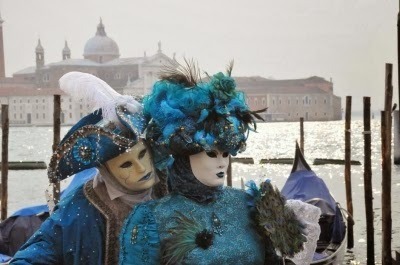
Masks and lavish costumes are an essential feature of the Venice Carnival and make the whole event magical. I remember couples parading and posing in the most extravagant outfits and masks, looking as if they'd just come out of an eighteenth century fantasy. The most instantly recognisable Venetian mask is the volto (Italian for face) or larva (meaning ghost in Latin), which is often white but can also be gilded and decorated. The Bautais a mask which covers the whole face. It has a no mouth and a strong chin line to enable the wearer to talk, eat and drink easily without having to remove it, and was often accompanied by a black cape - a tabarro - and a tricorne hat. During the eighteenth century the Venetian government legislated that all citizens were required to wear the Bauta during certain decision-making events to allow direct, free and equal democratic ballots. They were also prohibited from carrying weapons when masked.
The most instantly recognisable Venetian mask is the volto (Italian for face) or larva (meaning ghost in Latin), which is often white but can also be gilded and decorated. The Bautais a mask which covers the whole face. It has a no mouth and a strong chin line to enable the wearer to talk, eat and drink easily without having to remove it, and was often accompanied by a black cape - a tabarro - and a tricorne hat. During the eighteenth century the Venetian government legislated that all citizens were required to wear the Bauta during certain decision-making events to allow direct, free and equal democratic ballots. They were also prohibited from carrying weapons when masked.
 Other masks you see during the carnival are the Columbina, a half-mask that only covers the wearer's eyes, nose, and upper cheeks and is often decorated with gold, silver, crystals and feathers, and the Medico della peste (The Plague Doctor) mask. One of the most bizarre Venetian masks, it has a long nose shaped like a beak and glass openings for the eyes. It didn't start out as a carnival mask at all but was designed by 17th-century French physician Charles de Lorme who wore it whilst treating plague victims.
Other masks you see during the carnival are the Columbina, a half-mask that only covers the wearer's eyes, nose, and upper cheeks and is often decorated with gold, silver, crystals and feathers, and the Medico della peste (The Plague Doctor) mask. One of the most bizarre Venetian masks, it has a long nose shaped like a beak and glass openings for the eyes. It didn't start out as a carnival mask at all but was designed by 17th-century French physician Charles de Lorme who wore it whilst treating plague victims.
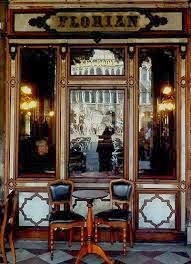 One of my fondest memories is going into the Caffè Florianon Piazza San Marco. Opened in 1720, it is one of the oldest cafés in existence and was visited by Casanova, Goethe and later Charles Dickens and Lord Byron. Another lovely memory is walking along the Laguna very early the morning after the carnival had ended. The town was eerily quiet, and the Laguna sparkled in pale golden sunlight. I promised myself I would go back...I hope one day I will.
One of my fondest memories is going into the Caffè Florianon Piazza San Marco. Opened in 1720, it is one of the oldest cafés in existence and was visited by Casanova, Goethe and later Charles Dickens and Lord Byron. Another lovely memory is walking along the Laguna very early the morning after the carnival had ended. The town was eerily quiet, and the Laguna sparkled in pale golden sunlight. I promised myself I would go back...I hope one day I will.
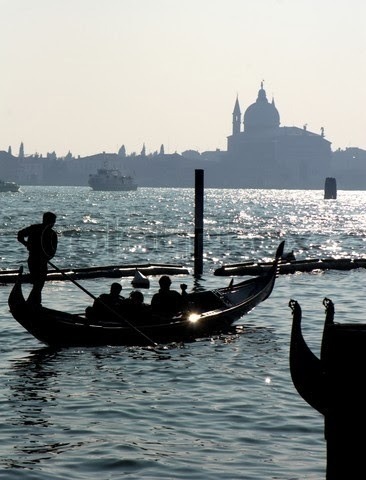
 It is thought that the Carnival was created to celebrate the victory of the Serenissima Republica against the Patriarch of Aquileia in 1162. It became more and more popular during the Renaissance and the eighteenth century until 1797, when it was outlawed under the rule of the King of Austria. The Carnival reappeared for short periods in the nineteenth century, but mostly for private soirées and celebrations, and it was only in 1979 that the Carnival made its official return.
It is thought that the Carnival was created to celebrate the victory of the Serenissima Republica against the Patriarch of Aquileia in 1162. It became more and more popular during the Renaissance and the eighteenth century until 1797, when it was outlawed under the rule of the King of Austria. The Carnival reappeared for short periods in the nineteenth century, but mostly for private soirées and celebrations, and it was only in 1979 that the Carnival made its official return.
Masks and lavish costumes are an essential feature of the Venice Carnival and make the whole event magical. I remember couples parading and posing in the most extravagant outfits and masks, looking as if they'd just come out of an eighteenth century fantasy.
 The most instantly recognisable Venetian mask is the volto (Italian for face) or larva (meaning ghost in Latin), which is often white but can also be gilded and decorated. The Bautais a mask which covers the whole face. It has a no mouth and a strong chin line to enable the wearer to talk, eat and drink easily without having to remove it, and was often accompanied by a black cape - a tabarro - and a tricorne hat. During the eighteenth century the Venetian government legislated that all citizens were required to wear the Bauta during certain decision-making events to allow direct, free and equal democratic ballots. They were also prohibited from carrying weapons when masked.
The most instantly recognisable Venetian mask is the volto (Italian for face) or larva (meaning ghost in Latin), which is often white but can also be gilded and decorated. The Bautais a mask which covers the whole face. It has a no mouth and a strong chin line to enable the wearer to talk, eat and drink easily without having to remove it, and was often accompanied by a black cape - a tabarro - and a tricorne hat. During the eighteenth century the Venetian government legislated that all citizens were required to wear the Bauta during certain decision-making events to allow direct, free and equal democratic ballots. They were also prohibited from carrying weapons when masked.
 Other masks you see during the carnival are the Columbina, a half-mask that only covers the wearer's eyes, nose, and upper cheeks and is often decorated with gold, silver, crystals and feathers, and the Medico della peste (The Plague Doctor) mask. One of the most bizarre Venetian masks, it has a long nose shaped like a beak and glass openings for the eyes. It didn't start out as a carnival mask at all but was designed by 17th-century French physician Charles de Lorme who wore it whilst treating plague victims.
Other masks you see during the carnival are the Columbina, a half-mask that only covers the wearer's eyes, nose, and upper cheeks and is often decorated with gold, silver, crystals and feathers, and the Medico della peste (The Plague Doctor) mask. One of the most bizarre Venetian masks, it has a long nose shaped like a beak and glass openings for the eyes. It didn't start out as a carnival mask at all but was designed by 17th-century French physician Charles de Lorme who wore it whilst treating plague victims.
 One of my fondest memories is going into the Caffè Florianon Piazza San Marco. Opened in 1720, it is one of the oldest cafés in existence and was visited by Casanova, Goethe and later Charles Dickens and Lord Byron. Another lovely memory is walking along the Laguna very early the morning after the carnival had ended. The town was eerily quiet, and the Laguna sparkled in pale golden sunlight. I promised myself I would go back...I hope one day I will.
One of my fondest memories is going into the Caffè Florianon Piazza San Marco. Opened in 1720, it is one of the oldest cafés in existence and was visited by Casanova, Goethe and later Charles Dickens and Lord Byron. Another lovely memory is walking along the Laguna very early the morning after the carnival had ended. The town was eerily quiet, and the Laguna sparkled in pale golden sunlight. I promised myself I would go back...I hope one day I will.

Published on March 03, 2014 10:15
February 13, 2014
French Valentine postcards: the romantic, the cute and the bizarre!
I have always loved to old postcards, and particularly Valentine cards. Here are a few charming old ones.
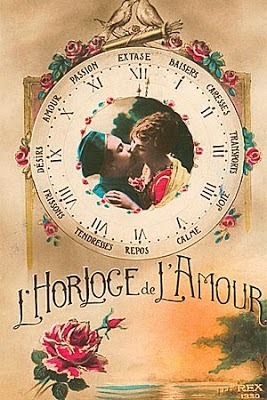


Now for the cute...French illustrator Raymond Peynet created his characters 'les amoureux' in 1942. The poet and his lover have become emblematic of Valentine Day in France and have inspired the famous George Brassens' song 'Les amoureux sur les bancs publics', featured in numerous books and posters and have even been made as dolls which are sought after collectables.
 And finally, the bizarre...
And finally, the bizarre...

She looks a little unsure about him trying to kiss her whilst smoking his cigarette, don't you think? And why is she wearing so much lipstick?



Now for the cute...French illustrator Raymond Peynet created his characters 'les amoureux' in 1942. The poet and his lover have become emblematic of Valentine Day in France and have inspired the famous George Brassens' song 'Les amoureux sur les bancs publics', featured in numerous books and posters and have even been made as dolls which are sought after collectables.
 And finally, the bizarre...
And finally, the bizarre...
She looks a little unsure about him trying to kiss her whilst smoking his cigarette, don't you think? And why is she wearing so much lipstick?
Published on February 13, 2014 11:03



